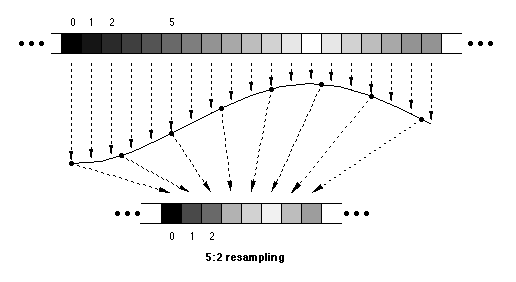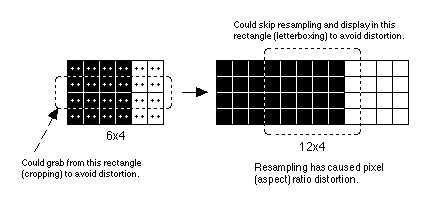
quantity definition symbol
======== ========================================= ===========
physical dimensions Height and width of screen image in cm. ScreenH,W
logical dimensions " " " " " " " pixels PixelsX,Y
pixel pitch Measured in cm/pixel. PixelPitchX,Y
(Could use dots-per-cm as the reciprocal of pitch.)Now the undisputed physical fact (length of an object) is:
ScreenW = PixelPitchX × PixelsX [Eq. 1]
(cm) (cm/pix) (pix)
(and likewise in the y-direction). Taking the ratio of y to x:
ScreenH PixelPitchY PixelsY
——————— = ——————————— × ——————— [Eq. 2]
ScreenW PixelPitchX PixelsX
physical pixel logical
(display) (aspect) (data)
ratio ratio ratio
(often 0.75)
All three of these ratios are called the aspect ratio in various contexts! Let's keep them separate. Hereafter we will drop the word "aspect" from the term "pixel ratio".Note that one may model pixels as points or rectangles. If they are points, then what we call "pixel size" should properly be called "pixel spacing." In addition, Eq. 1 should read
Screen = PixelSpacing × (Pixels - 1)
since the image does not extend to the left of the first pixel or to the right of the last. (See Fig. 1)



The original artwork can be created in a taller size and then squeezed to the proper size. In the process of squeezing, the image will get pre-distorted in such a way that it will look right again when displayed on the CD-i TV screen. The logical height of the original image should be the height of the final image multiplied by the pixel ratio of the final image. (The alert reader will note that the product has been rounded up to an even number, out of sheer obsessive-compulsion.) The general equation that gives the required starting height is Eq. 3b below.
How is this squeezing accomplished? Resampling can be described as the process of reconstructing a smooth curve that describes the variation of brightness & color from pixel to pixel and then finding values on that curve in between the original ones. This is illustrated in the figure below.

For example, imagine somebody asks us to convert a 6x4 image into a 12x4 image. We may do this by sampling the source image at twice the resolution horizontally, as shown in Fig. 5.

quantity definition symbol
======== ========== ======
source pixel ratio Ratio of pixel size dy/dx Rs
source logical grab rect Height & width in pixels of GrabH,W
region to be resampled
result logical rect Height & width in pixels of ResultH,W
resampled image
playback pixel ratio Pixel ratio on playback device Rp
pixel ratio distortion > 1 if playback is too skinny; D
< 1 if too fat.
Consider what the physical display dimensions of the grab rectangle are. From Eq. 2 the ratio of its height to width must be
GrabH
grab rect physical ratio = Rs × —————. [Eq. 3a]
GrabW
This rectangle may have to be squeezed or stretched (resampled) to make it fit into the playback rectangle, whose proportion is
ResultH
playback rect physical ratio = Rp × ———————. [Eq. 3b]
ResultW
It is the ratio of these two expressions that gives us the general expression for the distortion of the image:
Rs × GrabH/GrabW
D = ————————————————————. [Eq. 3c]
Rp × ResultH/ResultW
If numerator and denominator are equal, a figure that looked square when the original material was played back on the source hardware will still look square on the playback hardware; circles will not turn into ovals, etc. Thus to convert an image from a source pixel ratio of Rs to display properly on a device with pixel ratio Rp, we set D = 1, yielding
GrabH ResultH
Rs × ————— = Rp × ——————— [Eq. 4a]
GrabW ResultW
which is the same as
Rp ResultH
GrabH = —— × ——————— × GrabW [Eq. 4b]
Rs ResultW
which is the same as
GrabH/GrabW
Rp = Rs × ———————————————. [Eq. 4c]
ResultH/ResultW
Notice that Eq. 4b gives the starting (grab) height of an image to be converted as illustrated in Fig. 3 and described above. Eq. 4c is often described by saying that the pixel ratio is being converted from Rs to Rp. The distortion D of this conversion (just the ratio of Eq. 3a and 3b) is given above. Consider, though, that the expression for D is a ratio of ratios times ratios. Discussions of the value or meaning of D usually flounder in misunderstanding.
pixel height
pixel ratio = ————————————
pixel width
pixel clock frequency * scan line period 3
= ———————————————————————————————————————— × — [Eq. 5]
number of active lines 4
How do we understand this in terms of the foregoing? What's the 3/4 all about? Observe that
PixelsX = pixel clock frequency × scan line period (approximately) PixelsY = number of active lines (approximately)Substituting that (and pretending the approximate equalities are exact) yields
PixelsY 3
pixel ratio = ——————— × —
PixelsY 4
or
3/4 = pixel ratio × logical ratioThis is the same as Eq. 2. Thus Eq. 5 says that the CD-i player draws a picture on the screen whose proportions are 3:4 in all cases.
The equalities are not exact for reasons unknown to this author. The Green Book says to use 242.5 as the active line count for NTSC and 287.5 for PAL, instead of 240 and 280 respectively. Similarly, the product of pixel clock rate and active scan line period gives a pixel count larger than 384, or its high-res double value of 768.
To further confuse the issue, the numbers for pixel clock, scan line period, adn pixel ratio in § V.2.4 of the Green Book are incorrect. The correct numbers are:
format pixel clock freq scan line period pixel ratio ====== ================ ================ =========== 525 TV 15.1049 MHz 52.6555 µ s 1.230 [Green Book: 1.19] 625 15.0 MHz 52.0 µ s 1.017 [Green Book: 1.05]We have empirically measured the NTSC ratio to be 1.235 ± 0.003 and the PAL/SECAM ratio to be 1.019 ± 0.003.
Before encoding, correct the (pixel) aspect ratio of the digital image to be one of the following ratios, and set the pel aspect ratio index field of the Sequence header correspondingly.In fact, this is what the Green Book intends the passage to mean; unfortunately the pixel ratios given in the Green Book are wrong. The recommended ratios as written are:
1.19 [1.2015] if no aspect ratio distortion is to occur in decoders producing a 525-line output; in this case, 625-line decoders will have approximately 13% distortion.(The MPEG standard does not provide for these exact aspect ratios, so the values in brackets should be used.)1.05 [1.0695] if no aspect ratio distortion is to occur in decoders producing a 625-line output; in this case, 525-line decoders will have approximately 12% distortion.
1.12 [1.0950] if aspect ratio are to be equalized over both types of decoders.
We see that the given ratios are the same as the (incorrect) base case ratios. The correct ratios - the pixel ratios produced by the CD-i DV decoder board - are the same as the correct base case ratios. This is obvious (after the fact) when one realizes that the DV cartridge and the base-case video both use the same pixel clock. Thus video that is being prepared for DV should be converted to pixel ratios of 1.23 for NTSC, 1.017 for PAL, or the geometric mean, 1.118, for a compromise.
The pixel ratios for Video CD (White Book) are precisely 0.9 times those for CD-i. Hence the values are 1.1069 for NTSC and 0.9157 for PAL/SECAM. These numbers are supposed to be identical to the D1/CCIR-601 pixel ratios (see below); the White Book specifies them as such. The CD-i NTSC value is a slight deviation from the standard.
The format data for D1 are as follows:
full used
format logical dim. logical dim. pixel clock pixel ratio
====== ============ ============ =========== ===========
NTSC 720x486 712x486 13.5 MHz 1.095
PAL/SECAM 720x576 703x576 13.5 MHz 0.9157
Following is a list of recommended resampling choices for various combinations of D1 source and CD-i playback formats. The horizontal and vertical resampling ratios are given for each example, as well as the resulting pixel ratio. The numbers that correspond to digital filter complexity are the denominators (number following the colon) in the resampling ratio. Picture distortions of less than 2% are typically not noticeable. Distortions of 4% will be noticed by film professionals. Distortions of >6% will be noticed by a lot of people.
NTSC/24 D1 -> NTSC CD-i
691 9:5 384 x --> x Rp: 1.217 (1.1% distortion) 480 2:1 240 713 13:7 384 x --> x Rp: 1.253 (1.9% distortion) 476 17:8 224NTSC/29.97 D1 -> NTSC CD-i
690 15:8 368 x --> x Rp: 1.251 (1.7% distortion) 480 15:7 224 690 15:8 368 x --> x Rp: 1.233 (0.2% distortion) 472 19:9 224PAL/SECAM D1 -> PAL/SECAM CD-i
690 15:8 368 x --> x Rp: 1.031 (1.3% distortion) 574 19:9 272 699 19:10 368 x --> x Rp: 1.017 (0% distortion) 574 19:9 272NTSC D1 -> NTSC Video CD
702 2:1 352 x --> x Rp: 1.095 (1.0% distortion) 480 2:1 240PAL/SECAM D1 -> PAL/SECAM Video CD
702 2:1 352 x --> x Rp: 0.9157 (0% distortion) 576 2:1 288NTSC/29.97 D1 @ 1.85:1 letterbox -> NTSC CD-i
713 13:7 384 x --> x Rp: 1.244 (1.2% distortion) 371 19:9 176PAL/SECAM D1 @ 1.85:1 letterbox -> PAL CD-i
713 13:7 384 x --> x Rp: 1.035 (1.8% distortion) 436 21:10 208